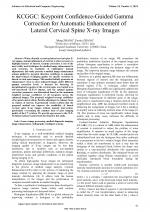| 2/2024 - 10 | View TOC | « Previous Article | Next Article » |
KCGGC: Keypoint Confidence-Guided Gamma Correction for Automatic Enhancement of Lateral Cervical Spine X-ray ImagesZHANG, M. |
| Extra paper information in |
| Click to see author's profile in |
| Download PDF |
Author keywords
image processing, medical diagnostic imaging, image enhancement, radiography, intelligent systems.
References keywords
image(20), enhancement(17), histogram(12), contrast(12), adaptive(10), equalization(9), correction(9), gamma(8), images(6), quality(5)
Blue keywords are present in both the references section and the paper title.
About this article
Date of Publication: 2024-05-31
Volume 24, Issue 2, Year 2024, On page(s): 93 - 100
ISSN: 1582-7445, e-ISSN: 1844-7600
Digital Object Identifier: 10.4316/AECE.2024.02010
Web of Science Accession Number: 001242091800010
SCOPUS ID: 85195662439
Abstract
When clinically reviewing lateral cervical spine X-ray images, manual adjustment of contrast is often necessary to highlight features of interest. Gamma correction is one of the most widely used techniques for medical image enhancement in such scenarios. In emulation of radiologists' manual adjustments, this study presents a medical image enhancement scheme guided by keypoint detection confidence to automate the improvement of imaging quality for specific vertebrae in lateral cervical spine images. This method initially generates an enhancement vector to store enhanced images under different gamma correction levels. A detector for detecting 34 morphological keypoints of the cervical spine was trained on a self-constructed CLX-34 dataset, and the optimal gamma correction parameter was determined based on the maximum weighted average confidence of all keypoints across the enhanced images. The proposed weighted average confidence of keypoints metric allows flexible adjustment to enhance focus on regions of interest. Experimental results confirm that the proposed method can improve the readability of lateral cervical spine X-ray images without manual intervention, particularly overcoming the common issue of poor imaging quality of the C7 vertebra. We provide open access to the CLX-34 dataset and pre-trained tools developed in this study. |
| References | | | Cited By |
Web of Science® Times Cited: 0
View record in Web of Science® [View]
View Related Records® [View]
Updated 2 weeks, 6 days ago
SCOPUS® Times Cited: 1
View record in SCOPUS® [Free preview]
View citations in SCOPUS® [Free preview]
[1] Class Activation Mapping-guided Delineation of ROI in Medical Images for Automatic Local Contrast Enhancement in Lateral Cervical Spine Radiographs, Xu, Jingyao, Zhang, Meng, Zhang, Fumin, 2024 IEEE 12th International Conference on Computer Science and Network Technology (ICCSNT), ISBN 979-8-3503-5079-1, 2024.
Digital Object Identifier: 10.1109/ICCSNT62291.2024.10776709 [CrossRef]
Disclaimer: All information displayed above was retrieved by using remote connections to respective databases. For the best user experience, we update all data by using background processes, and use caches in order to reduce the load on the servers we retrieve the information from. As we have no control on the availability of the database servers and sometimes the Internet connectivity may be affected, we do not guarantee the information is correct or complete. For the most accurate data, please always consult the database sites directly. Some external links require authentication or an institutional subscription.
Web of Science® is a registered trademark of Clarivate Analytics, Scopus® is a registered trademark of Elsevier B.V., other product names, company names, brand names, trademarks and logos are the property of their respective owners.
Faculty of Electrical Engineering and Computer Science
Stefan cel Mare University of Suceava, Romania
All rights reserved: Advances in Electrical and Computer Engineering is a registered trademark of the Stefan cel Mare University of Suceava. No part of this publication may be reproduced, stored in a retrieval system, photocopied, recorded or archived, without the written permission from the Editor. When authors submit their papers for publication, they agree that the copyright for their article be transferred to the Faculty of Electrical Engineering and Computer Science, Stefan cel Mare University of Suceava, Romania, if and only if the articles are accepted for publication. The copyright covers the exclusive rights to reproduce and distribute the article, including reprints and translations.
Permission for other use: The copyright owner's consent does not extend to copying for general distribution, for promotion, for creating new works, or for resale. Specific written permission must be obtained from the Editor for such copying. Direct linking to files hosted on this website is strictly prohibited.
Disclaimer: Whilst every effort is made by the publishers and editorial board to see that no inaccurate or misleading data, opinions or statements appear in this journal, they wish to make it clear that all information and opinions formulated in the articles, as well as linguistic accuracy, are the sole responsibility of the author.



